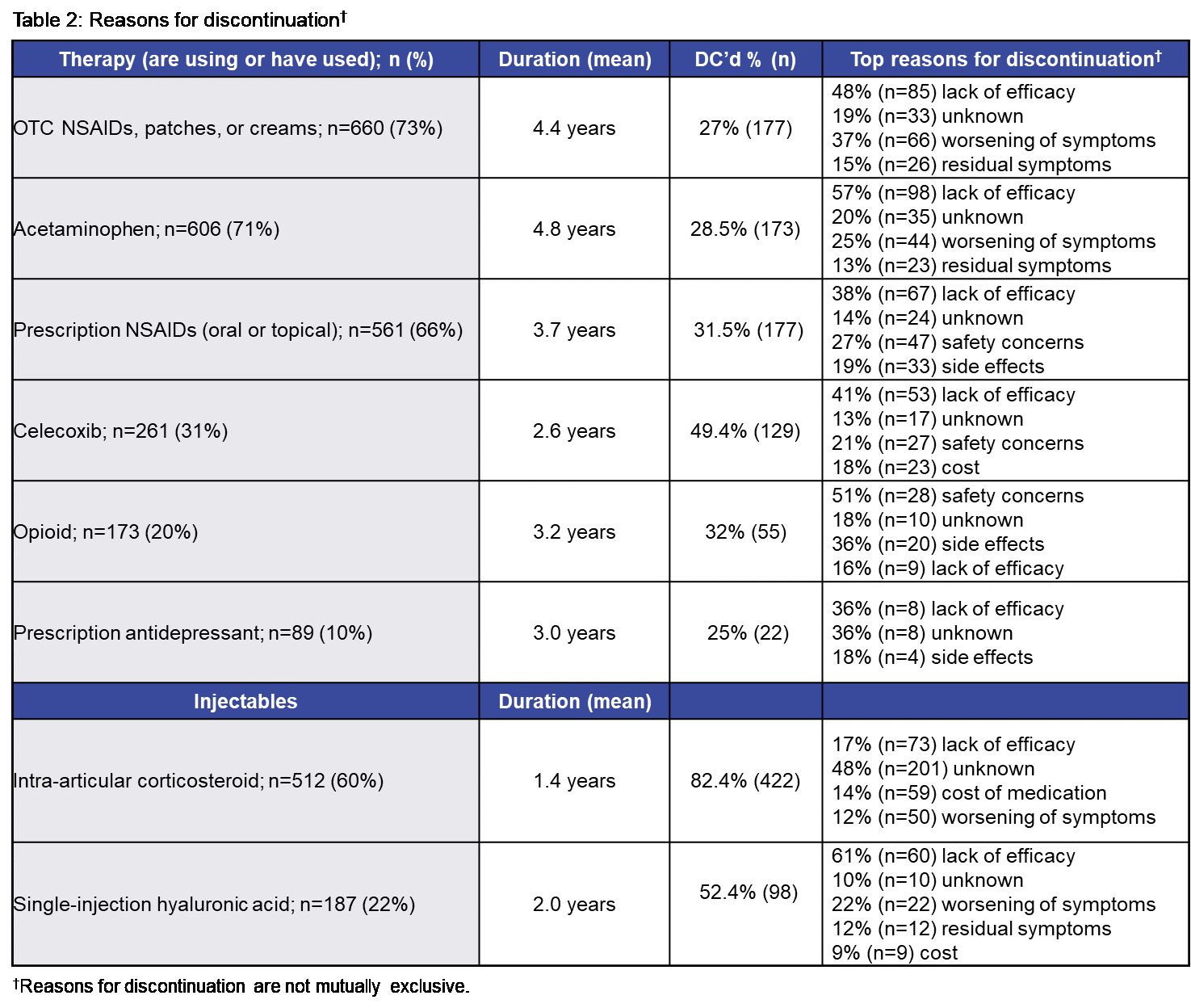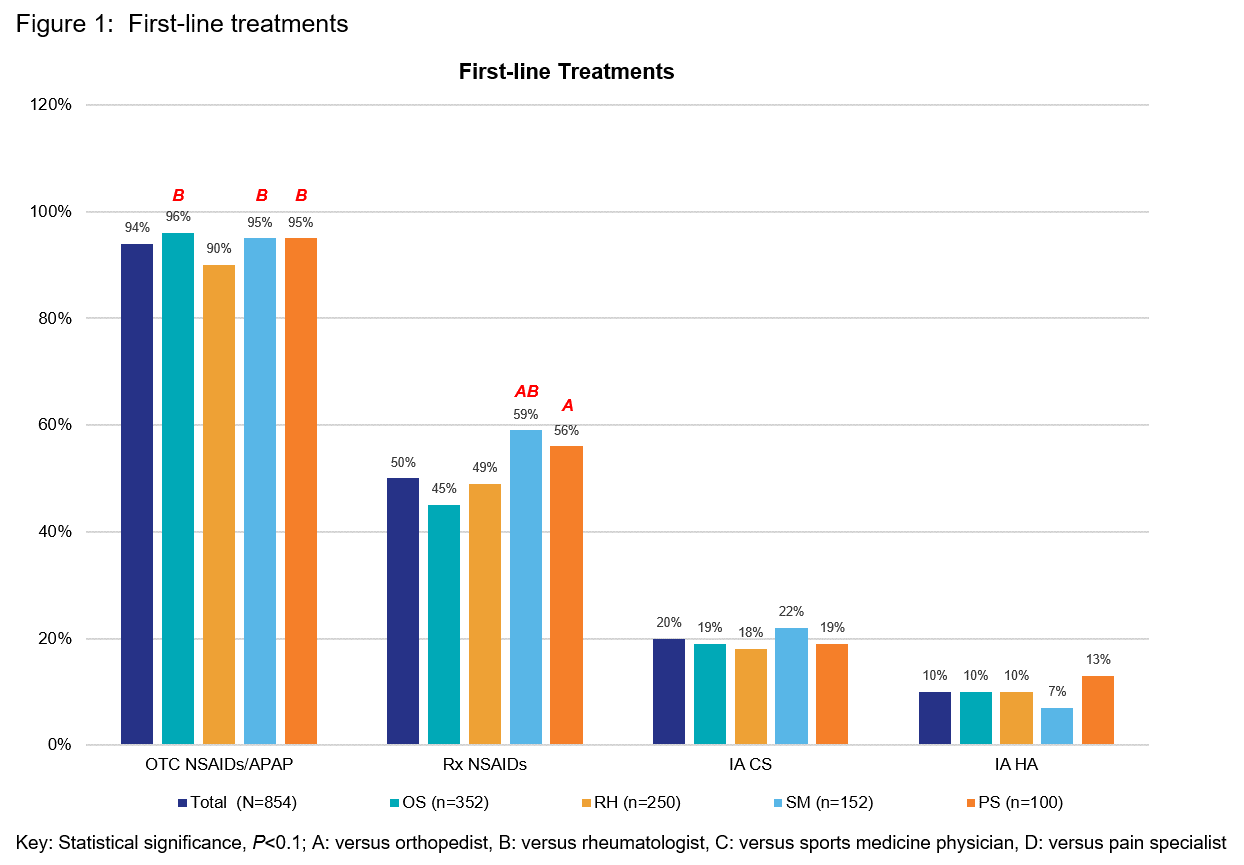Session Information
Session Type: Poster Session C
Session Time: 9:00AM-11:00AM
Background/Purpose: Knee osteoarthritis (OA) affects 32.5 million US adults and is typically treated by primary care physicians, rheumatologists (RH), orthopedists (OS), sports medicine (SM) physicians, and pain specialists (PS). Treatment is multimodal and comprises conservative and pharmacological therapies, intra-articular injections, and surgery. Guidelines provide recommendations in idealized settings, but little documentation exists in real world settings; hence, we aimed to assess patient characteristics and treatment patterns across 4 specialties.
Methods: This project was exempt from IRB review and HIPAA consent. Physicians with >2 years in practice and >10 knee OA patients per week were interviewed about their 2 most recent knee OA patients. Interviews (structured questions and answers) assessed demographics, referrals, comorbidities, time to treatment, and lines of therapy. As this study was designed to assess effect modifications, a confidence level of 90% was used.
Results: Patient demographics are shown in Table 1. Participating physicians included 125 RH, 176 OS, 76 SM, and 50 PS. Overall, 854 patients were included in the chart review. Patients were mean age 65 years, mean BMI 30.7, and 51% were female. First-line treatments are shown in Figure 1. Mean time between symptom onset and diagnosis was 3.4 years. Over 90% of patients used over-the-counter (OTC) nonsteroidal anti-inflammatory drugs (NSAIDs) and acetaminophen (APAP), with lowest use in RH patients. IA corticosteroids (CS) were used in ~20% of patients and hyaluronic acid (HA) in ~10% of patients, with similar use across specialties. Reasons for therapy discontinuation (DC) included lack of efficacy, AE/safety, and formulary/cost (Table 2). DC for lack of efficacy was 61% for single-injection HA. AE/safety concerns were reasons for DC of prescription (Rx) NSAIDs and opioids. Second-line treatments included CS >OTC Rx NSAIDs/APAP >HA. Third-line treatments were HA >CS >OTC Rx NSAIDs/APAP. Mean BMI was significantly higher in SM (33) and PS (32) patients compared with OS (30) and RH (30) patients. There were significantly more female RH patients (56%) than OS patients (47%). PS patients had significantly higher current unemployment (73%) due to an inability to perform function (15%) than patients treated by other specialties. RH, SM, and PS patients had significantly more comorbidities than OS patients. Overall, mean pain (NRS 0–10) was 5.6 and KL grade was 3. PS patients had significantly higher pain scores (6.5) than patients treated by other specialties. Limitations included selection bias, confounding, small N, and missing data.
Conclusion: PS see more patients with pain syndromes and higher BMIs. RH see more patients with rheumatoid conditions. OS patients used significantly more OTC NSAIDs/APAP than RH patients and were less likely than SM and PS patients to use Rx NSAIDs. Lack of efficacy drove most therapy changes. Of HA patients, 61% discontinued due to lack of efficacy. These data suggested that treatment patterns for knee OA were similar across physician types, and new therapies can provide additional options to currently available treatments that may have efficacy or safety concerns.
To cite this abstract in AMA style:
Bedenbaugh A, Lee V, Oderda G, Kennedy S, Brixner D, Tambiah J, McAlindon T. The Patient Journey in Knee OA: Variations in Patient Characteristics and Treatment by Physician Specialty [abstract]. Arthritis Rheumatol. 2020; 72 (suppl 10). https://acrabstracts.org/abstract/the-patient-journey-in-knee-oa-variations-in-patient-characteristics-and-treatment-by-physician-specialty/. Accessed .« Back to ACR Convergence 2020
ACR Meeting Abstracts - https://acrabstracts.org/abstract/the-patient-journey-in-knee-oa-variations-in-patient-characteristics-and-treatment-by-physician-specialty/



